
* The Gloster "Javelin" was the first British night / all-weather fighter designed specifically for the purpose. Although the development of the aircraft proved convoluted and it was not built in large numbers, it provided useful service for the British Royal Air Force (RAF) for over a decade. This document provides a history and description of the Javelin.
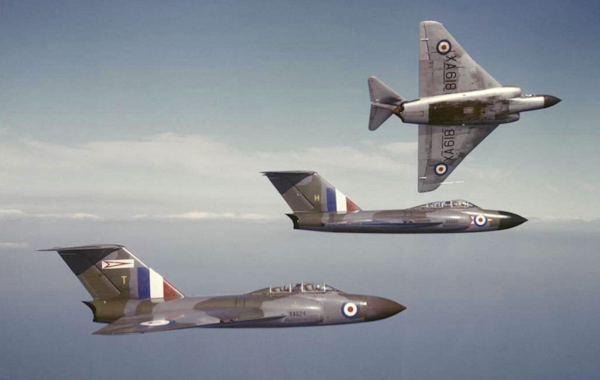
* In early 1947, the British Air Ministry released two requests for proposals to the country's aviation industry. The first request was designated "F.43/46" and specified a day interceptor, while the second request was designated "F.44/46" and specified a night fighter.
The Gloster company submitted designs in response to both requests, with the day interceptor design given the company designation of "P.234" and the night fighter design given the designation of "P.228". The two designs could not have been more different: the P.234 day interceptor was a radical design by the standards of the time, a delta-winged fighter with a vee tail, while the P.228 night fighter was essentially an evolved derivative of Gloster's classic Meteor day fighter.
Other manufacturers submitted proposals as well. There followed a bewildering shuffling of specifications and design submissions, the final result being that in early 1948, the Air Ministry ordered the construction of:
Initial flight of the first GA.5 prototype, WD804, was on 26 November 1951 with Gloster chief test pilot Squadron Leader W.A. "Bill" Waterton at the controls. The prototype was unarmed and otherwise not fitted with combat kit. It tended to buffet and flutter badly at high speeds, with the final result that it shook off both elevators on 29 June 1952. Waterton managed to get the machine back down on the ground without injury to himself, though the aircraft was totaled.
The second prototype, WD808, made its initial flight on 20 August 1952, but it spent most of the rest of the year on the ground while Gloster engineers worked on the buffet and flutter problems. It returned to the air in early 1953, but was unfortunately lost in a stall on 11 June 1953, killing the pilot, Peter Lawrence. The third prototype, WT827, performed its first flight on 7 March 1953; it was the first prototype to feature armament and radar. The fourth prototype, WT827, took to the air on 14 January 1954, to be soon passed on to the government Aircraft & Armament Experimental Establishment (A&AEE) at Boscombe Down for trials. The fifth and final prototype, WT836, performed its first flight on 20 July 1954.
Although the trials demonstrated a number of handling problems that proved difficult to work out, a production order for the GA.5 had been placed in 1952, with the type to be formally designated "Javelin Fighter All Weather Mark 1 (FAW.1)". Initial flight of the Javelin FAW.1 was on 22 July 1954, with test pilot "Dicky" Martin at the controls. While many of the FAW.1s were used for test and trials, they were delivered in enough numbers to build up two RAF squadrons in West Germany in early 1956. There were still enough difficulties with the type to force the RAF to specify an unusual level of limits on the maneuvers that could be performed with it. 40 FAW.1s were built in all.
BACK_TO_TOP* The Javelin FAW.1 provides a good baseline for description of the Javelin family. The FAW.1 was a very hefty-looking aircraft, built mostly of aircraft aluminum alloys plus some steel fittings, with a broad fuselage; broad and thick delta wings; plus a high tee tail, with a swept tailfin and a triangular tailplane.
The wing featured hydraulically actuated flaps and ailerons. There were slotted spoiler-type airbrakes on the top and bottom of each wing; the flap was actually fitted forward of the airbrake under each wing. Although early prototypes had a "straight" sweep with a sweep at 25% chord of 39.5 degrees, a "kinked" wing -- retaining the original sweep on the inner portion of the wing but lowering the sweep to 33.8 degrees outboard, resulting in wider wingtips -- was introduced in development, improving stall characteristics. The tailfin featured 47.6 degrees sweep at 25% chord, while the tailplane sweep was 42.8 degrees at 25% chord. The rudder was hydraulically actuated as were the elevators, with the entire tailplane able to adjust incidence under electrical power, apparently for takeoffs and landings.
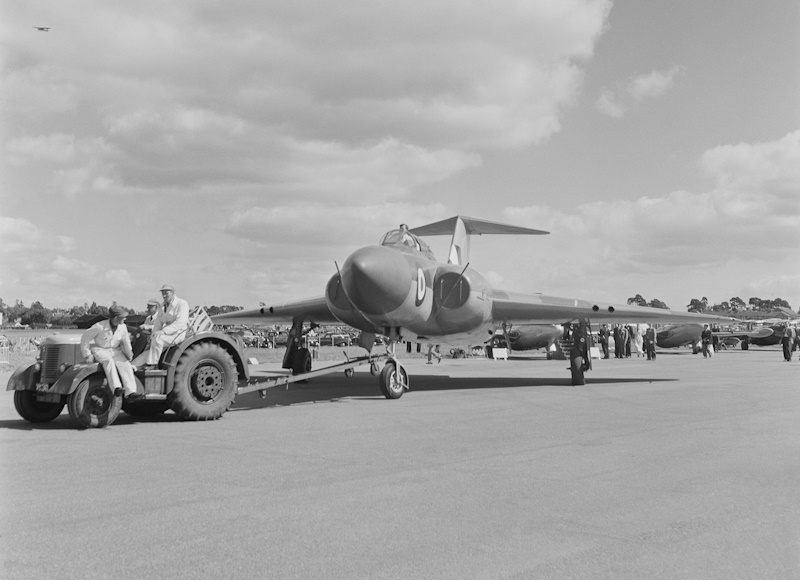
The Javelin was fitted with hydraulically-actuated tricycle landing gear, all gear assemblies featuring single wheels. The nose gear retracted backwards, while the main gear pivoted from the wings in towards the fuselage. The FAW.1 featured five fuel tanks in each wing, plus two fuel tanks in the forward fuselage, for a total of twelve internal tanks in all. US Air Force pilots who had flown Javelin prototypes during development had complained about the type's poor endurance, and so dual flush-mounted belly tanks with a capacity of 1,137 liters (300 US gallons) each were developed. These tanks were known as "bosom tanks" or "Sabrinas", the last being a nickname commonly applied to brassiere-like fixtures on British aircraft of that era -- in homage to very busty UK pinup girl / starlet Norma Sykes AKA Sabrina.
The pilot and radar operator were accommodated in a tandem-seat, air-conditioned cockpit under an all-round vision canopy that slid back to open. It was actually a four-piece canopy, with the rear segment sliding back over the fuselage to provide access for the radar operator in the back, and the second segment sliding back from the windscreen segment over a short fixed third segment to provide access for the pilot in the front. Early prototypes featured a different canopy scheme, with a solid metal rear cover featuring twin small portholes on each side, on the basis that the back-seater would be able to see his radarscope better; on second thought, there was a realization that it might be better to have a second set of eyes to keep a lookout. Both aircrew sat on Martin-Baker ejection seats. It is said that back-seaters had to have their legs measured from knee to hip -- if their thighs were too long, they might have their kneecaps sheared off by the radar display on ejection.
The aircraft was powered by twin non-afterburning Armstrong-Siddeley Sapphire Mark 6 (Sa.6) turbojet engines with 36.9 kN (3,765 kgp / 8,000 lbf) thrust each. Original design concepts had envisioned Rolls-Royce Avon engines instead, but they weren't powerful enough. The round inlets of the engines were spaced far apart, but the engines were fitted at an angle and the exhausts were set next to each other in the rear to reduce thrust asymmetry if an engine failed. There was a little pointed "pen-nib" fairing between the exhausts; early production suffered from buffeting and the fairing was introduced to fix the problem. The engines used pyrotechnic starters -- essentially what looked like a giant shotgun shell was inserted into a port and ignited to produce gas that turned over an engine, resulting in a cloud of black smoke at startup. If the engines didn't turn over with the first try, they'd be "flooded", and a second successful try would result in a huge tongue of flame blasting out the exhausts; it was spectacular but harmless.
The FAW.1 was fitted with Airborne Intercept Mark 17 (AI.17) radar and four 30-millimeter Aden revolver cannon, two mounted in each wing. Early prototypes had a rounded nose radome, but this configuration was too prone to erosion and was quickly replaced by a pointed radome. Initial concepts had envisioned armament of two Aden cannon and two 11.4-centimeter (4.5-inch) recoilless guns -- but though the RAF was very enthusiastic for a time for the big recoilless gun, probably fortunately it was a passing fancy, with attention moving on to guided air-to-air missiles (AAM). It was assumed from the outset that the Javelin would eventually have AAM armament, but aircraft development outpaced missile development and the FAW.1 relied on the four cannon for armament.
The standard color scheme for the Javelin through its operational life was a disruptive pattern of dark sea green and dark sea gray on top, with medium sea gray underneath. Some photos seem to show Javelins with a similar color scheme except for brown substituted for the dark sea green, but that may just have been a quirk of image coloration. Of course, trials Javelins were sometimes painted in gaudy high-visibility schemes.
BACK_TO_TOP* The next production version of the Javelin was the "Javelin FAW.2", which was fitted with American Westinghouse AN/APQ-43 radar, known as AI.22 in British service. The AN/APQ-43 was supplied to the UK under the US Mutual Defense Assistance Program (MDAP). The FAW.2 featured a larger nose radome, which could be pulled outward and hinged to the side to give access to the radar for service; the FAW.1's radome, in contrast, had to be unbolted and removed. The FAW.2 was otherwise hard to tell from the FAW.1. Some sources claim that the Sabrina tanks were introduced on the FAW.2 and not used on the FAW.1, but this is hard to confirm.
In practice, although the AI.17 had suffered from teething problems, after some time in service, it proved reliable enough; and though the AN/APQ-43 was a more sophisticated radar set on paper, it didn't prove to be much of an advance in practice. Initial flight of the first FAW.2 was on 22 October 1955, and 30 FAW.2s were built.
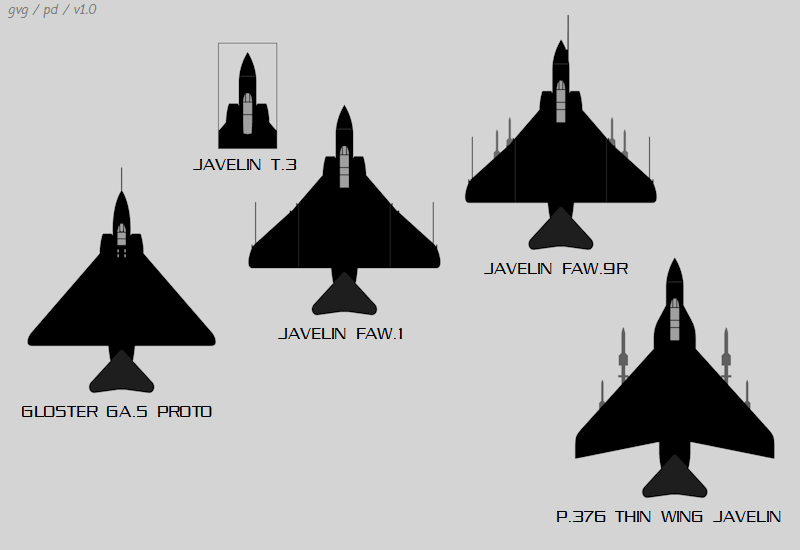
* The "Javelin Trainer Mark 3 (T.3)" was a dual-control trainer variant, with an elevated rear seat to give the flight instructor a better forward view, and an extended three-piece canopy. It was 1.12 meters (3 feet 8 inches) longer than the fighter variants, giving it a total length of 18.4 meters (60 feet 5 inches). The radar was deleted, but the cannon were retained; the longer fuselage helped maintain the center of gravity after removal of the radar, and also permitted fit of two more fuselage tanks, for a total of 14.
The Javelin T.3 also featured an "all moving" tailplane, discussed below. The initial flight of the first T.3 was on 6 January 1958 -- in terms of mark numbers, the T.3 appeared out of sequence, with higher fighter marks being introduced before it. 22 T.3s were built.
* The "Javelin FAW.4" was an attempt to improve the aerodynamic characteristics of the Javelin. The main change was fit of the "all moving" tailplane mentioned earlier, in which the entire tailplane was shifted hydraulically to provide elevator action; the tailplane actually retained elevators, but they were only used for trim. Other features included sets of "vortex generators" -- little fins applied in rows to the wings -- that set up air vortices over the wings to eliminate "dead air" at low speeds in hopes of holding off a stall, plus a stall alarm system; one of the problems with the Javelin was not only that it tended to go into dangerous stalls, it did so with little or no warning.
The improvements helped matters, but official limits on what maneuvers could be performed were still imposed on the FAW.4. The FAW.4 used the original AI.17 radar. The initial flight of the FAW.4 was on 19 September 1955, with a total of 50 FAW.4s built in all, production being split between Gloster and Armstrong-Whitworth.
The "Javelin FAW.5" was an FAW.4 with a new wing that incorporated flexible fuel tanks in the outer wings to counter complaints about the Javelin's poor endurance. Some sources describe the FAW.5 as an FAW.1 with the new wing, implying that it did not incorporate the aerodynamic improvements of the FAW.4, but pictures show the wing to be fitted with the rows of vortex generators, and presumably the FAW.5 also had the all-moving tailplane. Initial flight of the FAW.5 was on 26 July 1956, with 64 built, again with production split between Gloster and Armstrong-Whitworth.
The "Javelin FAW.6" was exactly the same as the FAW.5, but used the AN/APG-43 (AI.22) radar. Initial flight was on 15 January 1957 and 33 were built, all by Gloster.
* All these marks featured the Sapphire Sa.6 engine, in the form of the Sapphire 102 or similarly-rated Sapphire 103. The next Javelin, the "FAW.7", was fitted with uprated Sapphire Mark 7 (Sa.7) / Sapphire 203 engines with 48.9 kN (5,000 kgp / 11,000 lbf) thrust each. The FAW.7 also featured an extended rear fuselage to reduce drag, with the pen-nib fairing deleted; a yaw stabilization system linked to the rudder; and, significantly, new armament of four de Havilland Firestreak (originally Blue Jay) heat-seeking AAMs, carried on four underwing pylons. The missile fit was very clean aerodynamically and did little to impede performance.
The FAW.5 and FAW.6 had actually been designed to carry the Firestreak, but missile development was delayed, and in fact early FAW.7 production was delivered without AAM capability, to be retrofitted later. Four drop tanks with a capacity of 455 liters (120 US gallons) each could be carried on the pylons for ferry flights. AI.17 radar was retained as was Aden cannon armament, though in many cases two of the four cannon were deleted in the field. Initial flight of the FAW.7 was on 9 November 1956; it took a year more to get the variant into service. 142 were built, with the production split between Gloster and Armstrong-Whitworth.
The last new-production variant of the Javelin was the "Javelin FAW.8", with Sapphire Mark 7R (Sa.7R) / Sapphire 204 engines, which were Sa.7s modified with a limited afterburning ("reheat") capability, providing the same level of dry thrust as the Sa.7 but 59.6 kN (6,075 kgp / 13,390 lbf) afterburning thrust each. The new engines also featured an isopropyl nitrate starter system that was supposed to be more convenient than the cartridge starter system, but it didn't turn out to be that big an improvement. In fact, at least some pilots regarded the isopropyl nitrate starters as nightmarish, prone to causing disastrous fires, and far more troublesome than the cartridge starters -- though some sources claim that the cartridge starters caused engine fires every now and then as well. Development of turbine auxiliary power units for later generations of aircraft would prove to be the real solution to the engine starting issue.
The Sapphire 204's afterburner could only be engaged at high altitude; due to the limited throughput of the fuel pump system, if reheat was engaged at low altitudes the result would actually be a loss in thrust. Unlike earlier marks, the FAW.8 was fitted distinctive variable nozzles that extended from the rear fuselage. The FAW.8 featured the revised tail and Firestreak capability of the FAW.7 but used AN/APG-43 (AI.22) radar. It also featured some aerodynamic enhancements, including drooped leading edges on the outer wing panels, an aileron pitch stabilization system, and a rudder autostabilization system. First flight of the FAW.8 was on 9 May 1958, with 47 built, all by Gloster. The last performed its initial flight on 8 August 1960. It was not only the last of 433 Javelins built, including the five prototypes, it was also the last Gloster aircraft built.
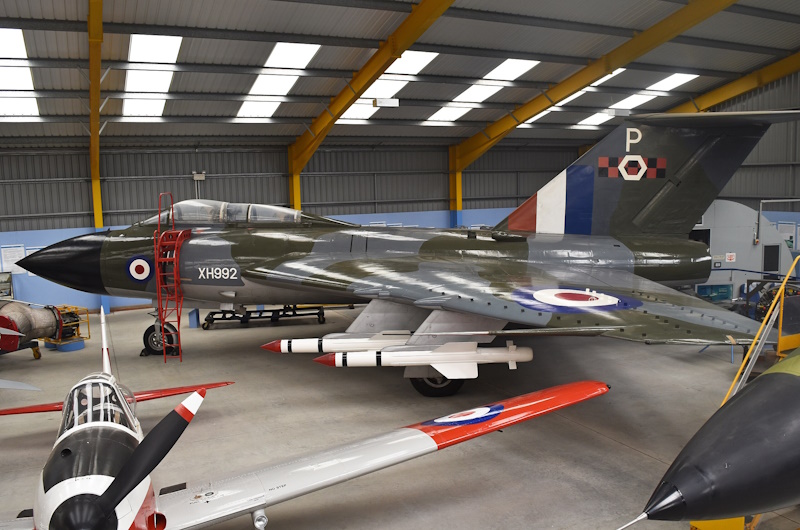
* That wasn't quite the end of the story, since Gloster rebuilt 116 FAW.7s to "Javelin FAW.9" standard by fitting Sapphire Sa.7R afterburning engines as well as the drooped wing outer leading edge. The conversions followed production of the FAW.8 and were completed in December 1961. Apparently a good number of FAW.7s never flew in their original configuration, being stockpiled, and then updated to FAW.9 spec before introduction to service.
_______________________________________________________________
GLOSTER JAVELIN FAW.9:
_______________________________________________________________
wingspan:
15.9 meters (52 feet 1 inch)
wing area:
86.12 sq_meters (927 sq_feet)
length:
17.3 meters (56 feet 9 inches)
height:
4.95 meters (16 feet 3 inch)
empty weight:
19,470 kilograms (42,930 pounds)
max loaded weight:
13,150 kilograms (29,000 pounds)
speed / sea level:
1,095 KPH (680 MPH / 590 KT)
service ceiling:
15,100 meters (49,500 feet)
range:
1,500 KM (930 MI / 810 NMI)
_______________________________________________________________
At least 40 FAW.9s were further updated with a long (6 meter / 20 foot) bolt-on refueling probe on the right side of the nose, with these updated machines designated "FAW.9(F/R)". The nose refueling probe configuration had been selected after earlier, unsuccessful trials of wing refueling probes. Top speed was restricted with the probe fitted. These machines were later further improved to "FAW.9R" standard by being qualified to carry four 1,046-liter (275 US gallon) external tanks.
* A total of 433 Javelins was built. The following list gives Javelin variants and production:
* A total of 19 RAF squadrons flew the Javelin at one time or another, with the type operating from the UK, West Germany, Cyprus, Singapore, and Zambia. Javelins flying out of Cyprus often operated in very tense circumstances, intercepting Turkish aircraft penetrating Cypriot airspace. Egyptian aircraft were intercepted on similar probes once or twice, and Javelins also occasionally escorted Soviet bombers and patrol aircraft flying through the eastern Mediterranean.
From 1963, there were border tensions between Malaya and Indonesia, with Singapore-based Javelins deployed to Malaya to perform border patrols.
Ten Cyprus-based Javelin FAW.9Rs were deployed to Zambia in late 1965, after Rhodesia declared independence from Britain. They flew south with a full load of six external tanks, raising a protest from the Egyptian government when they overflew Egyptian airspace without permission. The deployment lasted well into 1966. Conditions were primitive, with one Javelin losing a Firestreak when a nest of termites crawled up the landing gear and ate the solid propellant out of the missile.
No Javelin ever fired a shot in anger. By the early 1960s, British home defense units were converting to the English Electric Lightning, with the last Javelin in front-line service in Britain phased out in 1964. Javelins continued to serve in Germany until 1966, in Cyprus to 1967, and Singapore until 1968. No Javelin ever flew in foreign service.
* Pilots were generally fond of the Javelin, since it was sturdy and reliable, with a roomy cockpit, good field of view for the aircrew, and generally pleasant handling. Engine-out handing was regarded as benign, and it was one of the first RAF aircraft that could break Mach 1, if only in a dive. However, even in maturity -- with the all-moving tailplane, control-surface stabilization systems, and stall-warning system -- it couldn't be thrown around in any serious fashion, though pilots never seemed to worry much about it, seeing it as a matter of simple pilot training and competence. Nicknames that have been recorded include "Flying Triangle", "Flying Flat Iron", "Ace Of Spades" (for its profile as seen from below), "Harmonious Drag Master" (for its distinct sound), and "Grovelin" (for reasons unknown, but it sounds unflattering).

In exercises, the Javelin proved an effective interceptor against contemporary combat aircraft. At altitude, it was more than a match for a Hunter, with the Javelin's big wings giving much more lift and its highly effective airbrakes quickly allowing a Javelin pilot to turn the tables on a tail pursuer. Some believed that the Javelin could have been retained in service longer had it been fitted with updated radar and missiles, using it as a "missile truck" to perform air patrols. However, aircraft development was moving rapidly in the 1950s, leaving the Javelin well behind the learning curve, and there was no interest in even evaluating the Javelin with the improved Red Top derivative of the Fireflash.
* A good number of Javelins, in many cases FAW.1s, were used as test and trials platforms. One evaluated the de Havilland Gyron Junior turbojet, while another flight-tested the afterburning Rolls-Royce Avon RA.24R turbojet. A few Javelins remained in service with the A&AEE well into the 1970s, sometimes being painted in eye-catching red-white patterns or bright orange overall. About ten Javelins survive as static displays, mostly in the UK, but none remain in flying condition. Some Javelin enthusiasts have built impressive flying models, however, with one featuring a wingspan of 2.2 meters (7 feet 2 inches)
There was a range of unbuilt Javelin concepts. A strike aircraft based on the standard Javelin was considered, but given a thumb's down. In 1953, Gloster began design work on a "thin wing" Javelin, starting out as a standard Javelin with a new highly swept, thin wing for both interceptor and strike applications, gradually evolving to the more heavily redesigned Gloster "P.376" interceptor, with:
The P.376 was certainly a big, impressive aircraft, capable of Mach 1.8 clean at altitude, but it couldn't really compete on paper with "clean sheet" designs then being considered, and was also quickly shot down.
BACK_TO_TOPI've never been all that interested in the Javelin, finding it one of the stodgier RAF fighters, and I only ended up documenting it because I was short on time to do a good job on aircraft with more elaborate histories one month. On closer inspection, it proved to be just about as stodgy as it seemed. What is surprising is that it worked as well as it did, in spite of all its manifest limitations.
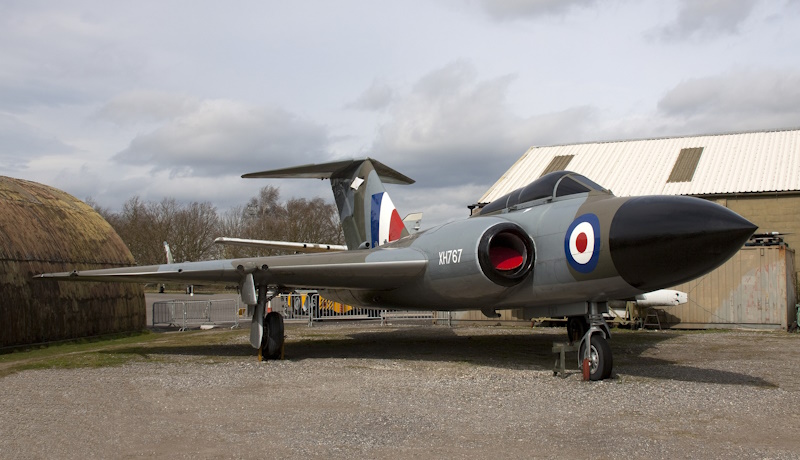
* Sources include:
I picked up a few interesting comments from a nice "Gloster Javelin" site in the UK for the second release of this document.
* Illustration credits:
* Revision history:
v1.0.0 / 01 jul 06 v1.0.1 / 01 jan 07 / Review & polish. v1.0.2 / 01 jan 08 / Review & polish. v1.0.3 / 01 dec 09 / Review & polish. v1.0.4 / 01 nov 11 / Review & polish. v1.0.5 / 01 oct 13 / Review & polish. v1.0.6 / 01 sep 15 / Review & polish. v1.0.7 / 01 aug 17 / Review & polish. v1.0.8 / 01 jul 19 / Review & polish. v1.0.9 / 01 may 21 / Review & polish. v1.1.0 / 01 apr 23 / Review & polish. v1.1.1 / 01 apr 25 / Review & polish.BACK_TO_TOP
